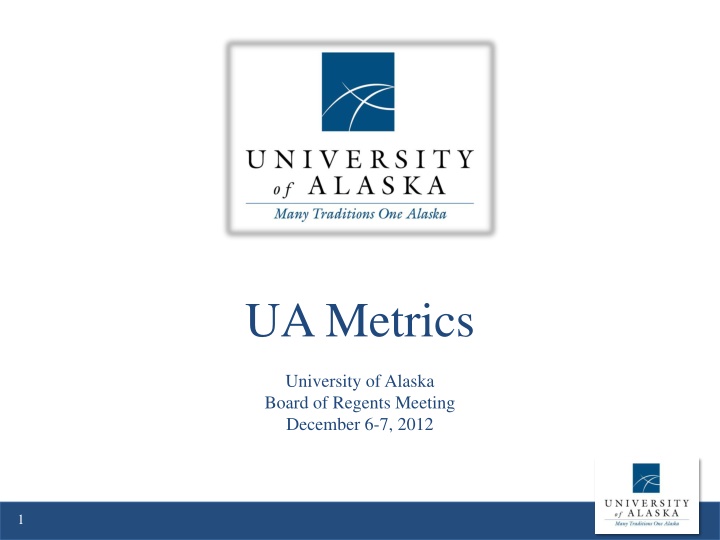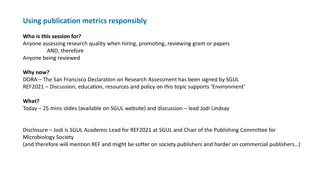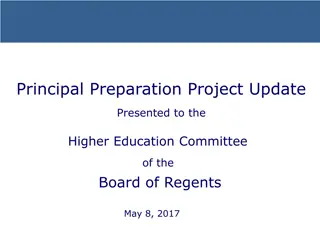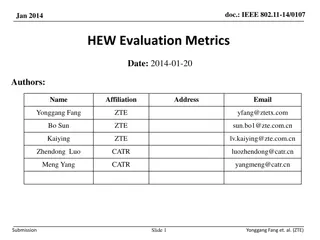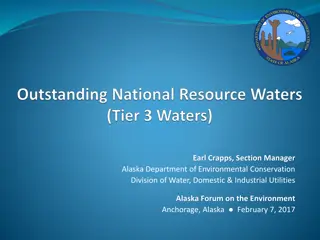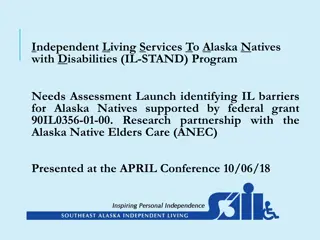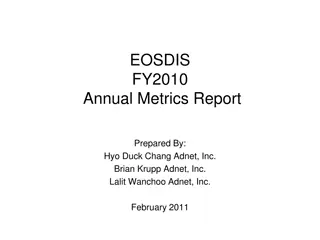UA Metrics: University of Alaska Board of Regents Meeting Insights
This document delves into the discussions and strategies presented at the University of Alaska Board of Regents meeting in December 2012. It covers topics like starting points, outcomes to track, what others are doing in the field, approaches taken by other states, the Strategic Direction Initiative, institutional accreditation indicators of achievement, and comparisons with other university systems. The content emphasizes the importance of tracking metrics and performance-driven funding to enhance accountability and progress in higher education.
Download Presentation

Please find below an Image/Link to download the presentation.
The content on the website is provided AS IS for your information and personal use only. It may not be sold, licensed, or shared on other websites without obtaining consent from the author.If you encounter any issues during the download, it is possible that the publisher has removed the file from their server.
You are allowed to download the files provided on this website for personal or commercial use, subject to the condition that they are used lawfully. All files are the property of their respective owners.
The content on the website is provided AS IS for your information and personal use only. It may not be sold, licensed, or shared on other websites without obtaining consent from the author.
E N D
Presentation Transcript
UA Metrics University of Alaska Board of Regents Meeting December 6-7, 2012 1
Topics Addressed Starting point. What others are doing? How can UA approach this? Outcome areas to track. 2
Starting Point University of Alaska mission statement State s results-based budgeting MAU institutional accreditation Indicators of Achievement Strategic Direction Initiative themes External guidance (AGB, NCAN, APLU, others) 3
What are others doing? Outcomes and efficiencies (ratios) Trends over time More than one set of metrics for different needs (dashboard monitoring vs. detail topic reports) Performance-driven funding External and peer comparisons 4
How other states are approaching this Source: From Information to Action: Revamping Higher Education Accountability Systems, National Governors Association, available at http://www.nga.org/ 5
The Strategic Direction Initiative Student Achievement & Attainment Productive Partnerships With Alaska s Schools Productive Partnerships With Alaska s Public and Private Industries Research & Development to Sustain Alaska s Economic Growth and Enhance Communities Accountability to the People of Alaska Each SDI Theme crosses every UA Mission area: instruction, research, and service 6
Institutional Accreditation Indicators of Achievement More than 140 different measures in use among UAA, UAF, UAS and PWSCC, with these commonalities: Learning outcomes Persistence Graduation Continuing education and employment Common to three: Faculty and student creative output (publications, etc.) High demand job area graduates Partnerships with local entities and private partners Public lectures, presentations and performances Degree to which student demographics reflect the population 7
Other University Systems University of California Berkeley Diversity Dashboard http://diversity.berkeley.edu/data-dashboard Minnesota State Colleges & Universities Accountability Dashboard http://www.mnscu.edu/board/accountability/index.html Center for Law and Social Policy (CLASP) The Return on Investment to Increasing Postsecondary Credential Attainment Dashboard http://www.clasp.org/postsecondary/pages?type=postsecondary_and_economic_success&id=0025 Also see handout example 8
Metric Development Process: Early Considerations Straw SDI-based metric set currently under review: President s Cabinet Faculty, Staff and Student Governance Statewide Academic Council (SAC) Student Services Council (SSC) Statewide Administrative Leadership Team (SALT) SDI priorities are still unfolding. Information provided by MAUs by November 30 deadline being compiled now. 9
Separate Metrics to Address Different Missions Should there be a common set of metrics for all MAUs but also allow each MAU to select a few metrics that are specific to their unique mission? Generally recommended to separate metrics for certificate/associate and baccalaureate programs, e.g., retention and graduation rates. 10
Access and Audience How public should each dashboard be? Highly visible information needs written analysis to help communicate context and avoid misinterpretation. Some information may be for internal business use only. 11
Timing How frequently does the committee want to receive updates on topics? Frequent reporting useful for highly variable measures. Near Real Time - applications, admissions and enrollment by student category (non-degree, traditional/non-traditional adult learner) and in programs of interest such as health, engineering, teacher education, transfers, graduate programs, APS students, others? Semester by Semester tuition and fees revenue, enrollment, others? Annual - research expenditures, retention, graduates, affordability, including financial aid and debt, program review, others? Biennial, Triennial - e-Learning, teacher education programs, health programs, and research. For example, should a comprehensive e- learning report be provided every two or every three years? 12
Proposed ASA Topic Report Schedule Which metrics should have dashboards for more frequent strategy and process progress updates? UPDATE TO TABLE BELOW PENDING Meeting December Topic Affordability Frequency Annual Research & Creative Activity Annual February Enrollment Biannual Teacher Education (SB241) & K-12 Alignment Biennial June Workforce Development/TVEP ? Annual September e-Learning Biennial Program Review & Specialized Accreditation Annual 13
How might UA approach this? Note the relationship between dashboard and detail topic reports: Metric: Research & Creative Activity Performance Evaluation Dashboard Annual Detail Report on Research & Creative Activity includes: Strategic Direction & the Future Funding & Productivity Undergraduate & Graduate Student Research Facilities Quality Creative & Scholarly Activity Intellectual Property Detail Topic Reports 14
UA Performance Evaluation Measures Related to Theme 1: Student Achievement & Attainment Degrees, certificates & endorsements awarded High demand job area degrees awarded Baccalaureate engineering degrees Health-related degrees Baccalaureate graduation rate, 6-Year 15
UA Performance Evaluation Measures Related to Theme 2: Productive Partnerships With Alaska s Schools Recent Alaska high school graduates at UA (include APS and UA Scholars info) First-time freshmen taking prep classes in the first semester of enrollment (include UA Scholars and APS) Teacher graduates and their placement 16
UA Performance Evaluation Measures Related to Theme 3: Productive Partnerships With Alaska s Public and Private Industries Non-credit instructional units delivered Publications distributed by cooperative extension service 17
UA Performance Evaluation Measures Related to Theme 4: Research & Development to Build and Sustain Alaska s Economic Growth and Enhance Communities Grant funded research expenditures Proportion of proposals funded Percentage of graduate students supported by grants Undergraduates completing an honors thesis or research or creative activity project 18
UA Performance Evaluation Measures Related to Theme 5: Accountability to the People of Alaska Baccalaureate graduates average time to degree Ratio of NGF to GF research revenue What is missing? Further student service assessment (transfers? affordability including financial aid and debt?) 19
